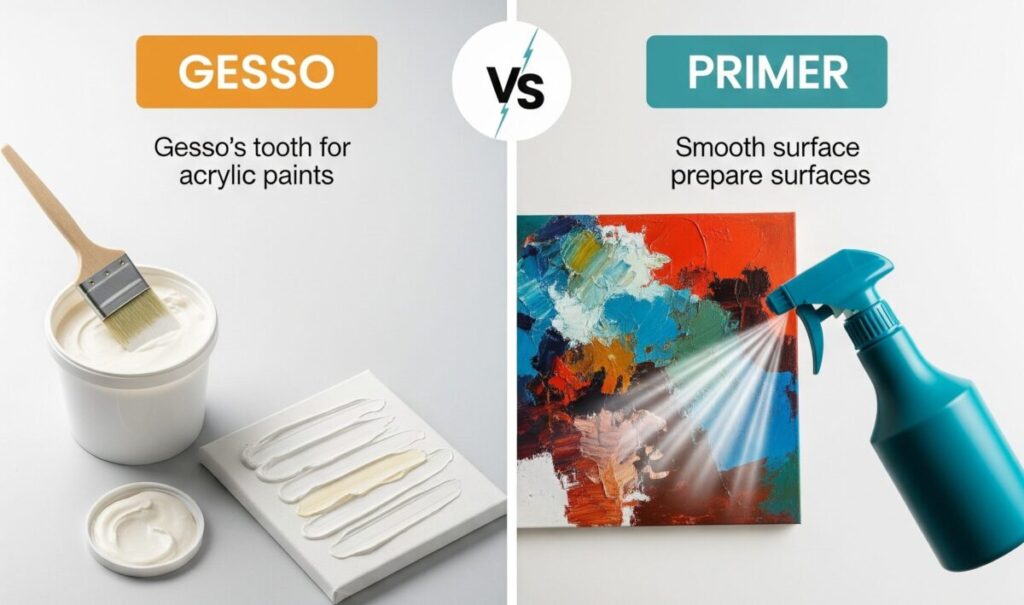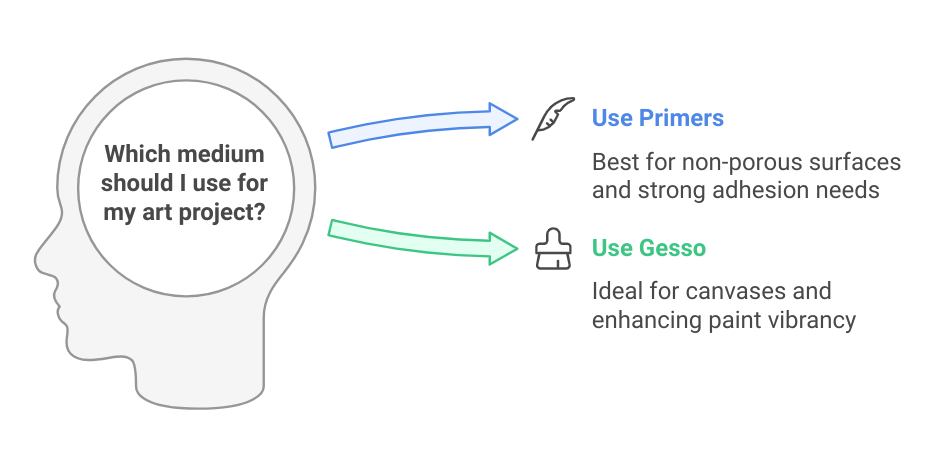If you’re just starting your artistic journey, you might be wondering about the difference between primers and gesso. While both materials help prepare surfaces for painting, they each have unique properties and uses that make them suitable for different situations. This comprehensive guide will explain everything you need to know about these essential art materials, helping you make the right choice Gesso vs Primer for your creative projects.
Key Points:

- Primers and Gesso are both surface preparatory coatings, but they have distinct compositions and uses.
- Primers are versatile, often acrylic- or oil-based, and designed for functional applications on diverse surfaces like canvas, wood, metal, walls, plastic, and non-porous materials. They create a smooth, stable surface for paint adhesion and can be formulated for specific needs (e.g., rust-inhibiting, bonding).
- Gesso (traditionally chalk/gypsum/plaster of Paris with animal glue, now mostly acrylic-based with calcium carbonate and titanium white) is a specific type of primer primarily used in fine art to prepare artistic surfaces like canvases and wooden panels. It provides a slightly textured, absorbent surface ideal for gripping paint.
What Are Primers?
Primers are preparatory coatings that create a smooth, stable surface for paint to adhere to. Think of primers as the foundation of a house—they provide the strong base needed for everything that comes after. Artists and DIY enthusiasts use primers on various surfaces, including:
- Canvas
- Wood
- Metal
- Walls
- Plastic and other non-porous materials
Modern primers come in different formulations, each designed for specific uses. For example, oil-based primers work well for blocking stains and sealing wood, while water-based primers are ideal for drywall and previously painted surfaces. Additionally, specialized primers include rust-inhibiting formulations for metal or bonding primers for glossy and non-porous materials like glass and plastic. These tailored options ensure durability and even paint application in various artistic and functional projects.
What Is Gesso?
Gesso (pronounced “jesso”) is a specific type of primer traditionally made from chalk, gypsum, or plaster of Paris mixed with animal glue and white pigment. Today, most gesso formulations are acrylic-based, combining calcium carbonate with an acrylic polymer medium and titanium white pigment.
The word “gesso” comes from the Italian word for chalk or plaster, highlighting its origins in traditional art practices and its enduring relevance in providing a reliable surface for modern painting techniques. Artists have used gesso for centuries, particularly during the Renaissance, to prepare wooden panels and other surfaces for painting. It remains a staple in fine art, offering an ideal surface for both acrylic and oil paints.
Key Differences Between Primers and Gesso
1. Composition and Texture
The main difference between primers and gesso lies in their composition:
- Primers: Typically acrylic- or oil-based with additives tailored to specific surfaces (e.g., rust inhibitors for metal, adhesion agents for slick surfaces).
- Gesso: Contains calcium carbonate, titanium white, and an acrylic binder, resulting in a chalky, textured finish.
Gesso’s slight texture makes it ideal for gripping paint, which benefits techniques like layering and glazing by ensuring pigments adhere well to the surface. In contrast, primers often dry to a smoother surface, making them better suited for applications where a uniform, non-textured base is preferred.
2. Intended Use
- Primers: Primarily designed for functional applications, such as preparing unconventional surfaces like metal or plastic for strong paint adhesion.
- Gesso: Specifically formulated for fine art, particularly for preparing canvases, wooden panels, or other art surfaces.
3. Absorbency
- Gesso: Creates a slightly absorbent surface, ideal for gripping paint layers and allowing rich color application.
- Primers: Often create a sealed, non-absorbent surface that prevents paint from soaking into the substrate.
4. Application Techniques
- Gesso: Typically applied in multiple thin layers with light sanding between coats for an even finish.
- Primers: Require fewer coats and generally involve less surface preparation, making them more convenient for experimental or large-scale art projects.
When to Use Primers vs. Gesso

Understanding when to use primers or gesso is key to achieving the best results for your project. For example, using a primer instead of gesso on a canvas might result in a surface too smooth and non-absorbent for acrylic paint, leading to difficulty achieving proper layering or texture in your artwork.
Use Primers When:
- Preparing unconventional art surfaces like metal or plastic
- Creating mixed media pieces where non-porous surfaces are involved
- Working on experimental or large-scale art installations that require strong adhesion
- Protecting the substrate from bleeding or staining caused by the paint medium
Use Gesso When:
- Preparing canvases for painting
- Working on fine art pieces
- Needing a slightly textured, absorbent surface
- Using acrylic or oil paints for traditional artwork
- Enhancing color vibrancy and adhesion on artistic surfaces
Famous Artists Who Mastered Gesso and Primers
Famous artists throughout history have mastered the use of gesso and primers in their masterpieces. During the Renaissance, Leonardo da Vinci meticulously applied traditional gesso (made from gypsum and animal glue) in multiple thin layers on wooden panels, creating the perfect surface for works like the Mona Lisa. Michelangelo used a special gesso mixture containing marble dust for the Sistine Chapel ceiling, which helped his work survive centuries.
In the Baroque period, Rembrandt experimented with double grounds and tinted primers for his signature lighting effects, while Caravaggio used dark-tinted primers to achieve his dramatic shadows. Modern masters brought their own innovations – Van Gogh sometimes added colored primer layers, O’Keeffe preferred pristine white gesso surfaces, and Rothko developed custom mixtures for his luminous abstract works.
Today’s artists like Gerhard Richter and Jenny Saville continue this tradition while incorporating modern materials and techniques, proving that proper surface preparation remains crucial for creating lasting artwork.
Table of Famous Painters who likely utilized Gesso or Primers in their Work

| Painter | Era/Movement | Notable Use of Gesso/Primer |
| Giotto di Bondone | Early Renaissance (14th Century) | Known for his tempera paintings on wood panels. Traditional gesso (made with parchment glue and slaked plaster of Paris) was crucial for preparing these surfaces for tempera and gold leaf. |
| Jan van Eyck | Early Netherlandish (15th Century) | A pioneer of oil painting, van Eyck’s works often utilized a white gesso ground beneath layers of oil glazes, contributing to the luminous quality of his paintings. |
| Sandro Botticelli | Early Renaissance (15th Century) | Famous for his tempera on canvas works like “The Birth of Venus.” Gesso would have been used to prime the canvas, providing a smooth, absorbent surface for the tempera medium. |
| Leonardo da Vinci | High Renaissance (15th-16th Century) | While the “Mona Lisa” was famously painted on raw wood, Leonardo, like many Renaissance masters, would have used gesso to prepare other wood panels for his oil paintings, creating a stable and bright base. |
| Raphael | High Renaissance (16th Century) | A master of the High Renaissance, Raphael employed gessoed wood panels for many of his oil paintings, ensuring a bright and smooth foundation for his intricate compositions. |
| Titian | High Renaissance/Venetian School (16th Century) | Known for his vibrant use of color and oil glazes. While Venetian painters sometimes used colored grounds, a gesso layer would still have been a crucial initial step in preparing their canvases or panels. |
| Peter Paul Rubens | Baroque (17th Century) | Rubens utilized various painting supports, including wood panels and canvas. A gesso or primer layer would have been standard practice to prepare these surfaces for his dynamic oil compositions. |
| Rembrandt van Rijn | Dutch Golden Age (17th Century) | Rembrandt’s masterful use of light and shadow in his oil paintings often benefited from carefully prepared grounds, which could include gesso to provide a consistent and receptive surface. |
| Johannes Vermeer | Dutch Golden Age (17th Century) | Vermeer’s exquisite light and detail in his oil paintings indicate a meticulous approach to surface preparation, likely involving gesso or a similar primer to achieve his characteristic smooth finishes. |
| Jean-Honoré Fragonard | Rococo (18th Century) | As painting styles evolved, so did primers, but the principle of preparing the surface remained. Fragonard’s light and airy oil paintings would have relied on a well-primed support. |
| J.M.W. Turner | Romantic (19th Century) | Turner’s expressive oil paintings, often on canvas, would have been applied to primed surfaces, allowing for the building up of his characteristic atmospheric effects and vibrant colors. |
| Claude Monet | Impressionism (19th Century) | Impressionists often worked directly on commercially prepared canvases, which would typically have been pre-primed with gesso or a similar ground. This provided a consistent, often white, surface that enhanced the vibrancy of their colors. |
| Vincent van Gogh | Post-Impressionism (19th Century) | Van Gogh, like other artists of his time, would have used commercially gessoed canvases, which allowed him to apply his thick, impasto brushstrokes effectively. |
| Pablo Picasso | Modern Art (20th Century) | Across his many stylistic periods, Picasso would have utilized various commercially primed canvases and other supports, incorporating the prepared surfaces into his diverse artistic approaches. |
| Edward Hopper | American Realism (20th Century) | Hopper’s distinctive style, characterized by crisp lines and a strong sense of light, was often executed on commercially prepared canvases, meaning they would have had a gesso or acrylic primer base. |
| Bob Ross | Contemporary (20th Century) | While often associated with “Liquid White” (a very thin primer for wet-on-wet oil painting), Bob Ross also utilized gesso, particularly black gesso, for creating dark backgrounds in his “Joy of Painting” series, especially from Season 9 onwards. |
Tips for Using Both Materials
To ensure optimal results, follow these best practices regardless of whether you’re using primers or gesso:
- Surface Preparation: Clean and dry the surface thoroughly to remove dust, grease, or residues.
- Thin Layers: Apply thin, even coats rather than one thick layer to avoid cracking or uneven textures.
- Drying Time: Allow each layer to dry completely before applying the next.
- Sanding: Sand between layers if you want a smoother finish (especially for gesso).
- Ventilation: Work in a well-ventilated area to avoid inhaling fumes or dust.
Cost Considerations

The cost of primers and gesso can influence your decision:
- Primers: Generally more affordable and available in bulk quantities for large projects.
- Gesso: Typically more expensive per ounce but specifically tailored for fine art applications.
Investing in the right product can save you time and ensure better results. A simple checklist can help: assess the type of surface you’re working on, the type of paint you’ll use, whether you need absorbency or smoothness, and the scale of your project. Matching these factors to the right product ensures a solid foundation for your art.
Common Misconceptions
There are several misconceptions about primers and gesso. Let’s clear up some of the most common ones:
- Gesso vs. White Paint: Gesso is not simply white paint; it’s a specially formulated surface preparation material.
- Substitutability: Not all white primers can replace gesso for fine art applications.
- Color Variations: Gesso isn’t always white; it’s available in clear and colored versions to suit different artistic needs.
- Effectiveness: Primers are not inferior to gesso; they’re designed for different purposes and surfaces.
Conclusion
While both primers and gesso prepare surfaces for painting, their distinct properties make them suitable for different applications. Primers excel in functional, experimental, or mixed-media projects, while gesso is the go-to choice for artists creating fine art. By understanding these differences, you can select the right product for your project and achieve professional results.
Whether you’re painting a masterpiece or exploring creative techniques, the proper preparation makes all the difference. Invest in quality materials, and enjoy the satisfaction of a job well done on your artistic journey.
FAQs Gesso vs Primer:
Here are some frequently asked questions related to “primers and gesso,” as if they were generated from common Google searches:
- What is the main difference between gesso and primer?
- The main difference lies in their composition, texture, and intended use. Gesso, specifically for fine art, contains calcium carbonate for a slightly textured, absorbent surface, while general primers are more versatile, often smoother, and designed for various functional applications on diverse materials.
- Can I use regular primer instead of gesso for acrylic painting?
- While some general primers might work, it’s not ideal for fine art. Regular primers often create a non-absorbent surface, which can hinder proper layering and texture application with acrylic paints, unlike gesso’s slightly absorbent finish.
- Do I need to prime a canvas before painting?
- Yes, it’s highly recommended. Priming with gesso prepares the canvas by providing a consistent, slightly absorbent surface that allows paint to adhere well, enhances color vibrancy, and protects the canvas fibers from the paint.
- What is gesso made of?
- Traditionally, gesso was made from chalk, gypsum, or plaster of Paris mixed with animal glue and white pigment. Modern gesso formulations are typically acrylic-based, combining calcium carbonate with an acrylic polymer medium and titanium white pigment.
- When should I use a general primer for art projects?
- Use a general primer when working on unconventional art surfaces like metal or plastic, creating mixed-media pieces, or for large-scale, experimental art installations where strong adhesion to diverse substrates is crucial.
- Can I use house primer on canvas?
- While technically possible, it’s generally not recommended for fine art. House primers are formulated for different purposes (e.g., sealing walls) and may result in a surface that is too smooth, non-absorbent, or not archival for artistic painting. Gesso is specifically designed for artistic surfaces.
- Is gesso just white paint?
- No, gesso is not just white paint. It’s a specially formulated surface preparation material that contains additives like calcium carbonate to provide specific properties (texture, absorbency, adhesion) that regular white paint does not offer for art surfaces.
- Does gesso come in colors other than white?
- Yes, while traditionally white, gesso is available in clear and colored versions to suit different artistic needs and preferences.



